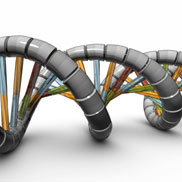
The chemical nature and structure of DNA were not elucidated until the middle of the twentieth century. Prior to that point, scientists had spent years speculating about which of the many types of molecules within cells contained the hereditary information. Was it protein? Was it something else — perhaps even a molecule they had yet to discover? Eventually, researchers zeroed in on DNA as the substance responsible for the transfer of traits from one generation to the next. From there, the race was on to learn more about this remarkable molecule.
Who first identified DNA?
Although James Watson and Francis Crick determined the double-helical structure of DNA, DNA itself was identified nearly 90 years earlier by Swiss chemist Friedrich Miescher. While studying white blood cells, Miescher isolated a previously unknown type of molecule that was slightly acidic and contained a high percentage of phosphorus. Miescher named this molecule "nuclein," which was later changed to "nucleic acid" and eventually to "deoxyribonucleic acid," or DNA. Interestingly, Miescher did not believe that nuclein was the carrier of hereditary information, because he thought it lacked the variability necessary to account for the incredible diversity among organisms. Rather, like most scientists of his time, Miescher believed that proteins were responsible for heredity, because they existed in such a wide variety of forms.
















